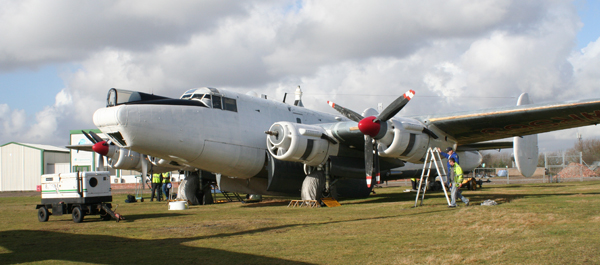
The hope is that Shackleton WR963 will soon be fully taxiable, though almost certainly never again flyable.
The four-engine Avro Shackleton long-range maritime patrol bomber, long known as “the Shack,” was the ultimate version of the World War II Avro Lancaster bomber, which itself looked a bit like a winged chicken coop. The Lancaster morphed into the Avro Lincoln, and the Lincoln lent its wings, landing gear and taildragger stance to the Shackleton, which had a new fuselage and four Rolls-Royce Griffon engines, each driving a pair of contrarotating propellers. (The conflated airflow over and between the opposing propellers gave the Shack another nickname: Growler.)
The Griffons were a little more powerful than the classic Merlins that had powered the Lincoln, but they and their pinwheeling props were much more efficient. At the 1960 Farnborough airshow, RAF Coastal Command used its slots in the flying displays for a standard, unmodified Shack to take off on a routine mission every afternoon. The next morning, some 22 hours later, the same Shack landed back at Farnborough, a convincing endurance demonstration.
There are grounded Shackletons parked in museums here and there, and there’s one impeccable, still-flyable Shack at the South African Air Force Museum but no current crew to operate it. The SAAF has also ordered its museum to stop flying the aircraft due to its uniqueness and value.
In Britain, the all-volunteer Shackleton Preservation Trust (shackleton963.co.uk) has spent 13 years renovating a 1954 AEW2 that had served a remarkable 37 years and logged over 15,000 flying hours with the RAF. It was put out to pasture in 1991—with aeronautical charts and several of its crew’s logbooks still scattered about the cabin. Led most recently by ex-Shackleton crewman John Cubberly, who spent more than
400 hours aboard WR963, the very Shackleton that his group of volunteers has brought back to life, the Trust team includes ex-RAF engineers and crewmembers.
The hope is that 963 will soon be fully taxiable, though almost certainly never again flyable. At one point during its tenure with the Trust, the Shack had four runnable engines, but problems with camshaft wear on the rare Griffons have reduced that number to one, though the group has several spares. “The intention is that WR963 will be returned to taxiable status within the next 12 months,” Rich Woods of the Trust said in mid-January. “The work on the engines is nearly at an end.”




